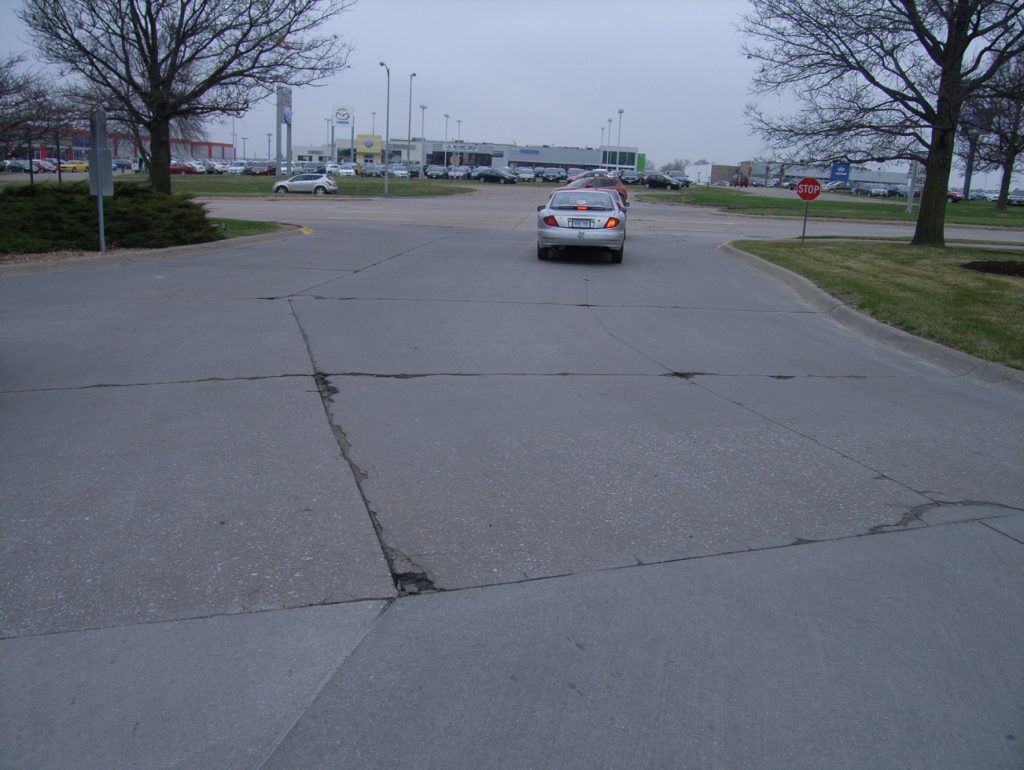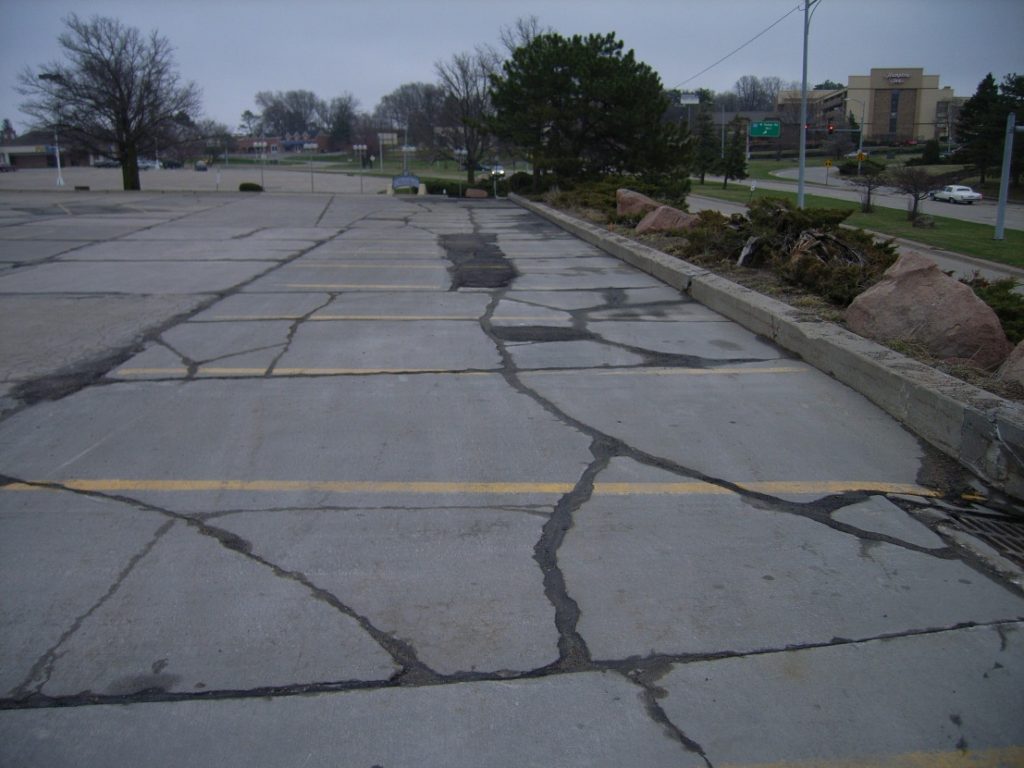
Concrete Conditions
Linear Cracking
These cracks divide the slab into two or three pieces and are usually caused by a combination of repeated traffic loading, thermal gradient curling, and repeated moisture loading. Slabs divided into four or more pieces are counted as divided slabs. Hairline cracks only a few feet long and not extending across the entire slab are counted as shrinkage cracks.

Severity Levels
Low Non-filled cracks less than 0.5-inch or filled cracks of any width with the filler in satisfactory condition. No faulting exists.
Medium One of the following conditions exists: (1) non-filled crack with a width between 0.5 and 2.0 inches; (2) non-filled crack of any width less than 2.0 inches with faulting of less than 0.375 inch; or (3) filled crack of any width faulting less than 0.375 inches.
High One of the following conditions exists: (1) non-filled crack with a width greater than 2.0 inches, or (2) filled or non-filled crack of any width with faulting greater than 0.375 inches.
How to Measure
After severity has been identified, the distress is recorded as one slab. If two medium severity cracks fall within one slab, the slab is counted as having one high severity crack. Slabs divided into four or more pieces are counted as divided slabs. In reinforced slabs, cracks less than 0.5-inch wide are counted as shrinkage cracks. Slabs longer than 29.5 feet are divided into “virtual slabs” of approximately equal length, with joints in perfect condition.
Edited From: Concrete Surfaced Roads & Parking lots, PAVER Distress Identification Manual, Developed by: US Army Corps of Engineers ERDC-CERL, M.Y. Shahin and S.D. Kohn. Photographs from Zimmer Consultants
Corner Break
A corner break is a crack that intersects the joints at a distance less than or equal to half the slab length on both sides, measured from the corner of the slab. For example, a slab measuring 11.5 by 20 feet that has a crack 5 feet on one side and 11.5 feet on the other side is not considered a corner break; it is a diagonal crack. However, a crack that intersects 4 feet on one side and 8 feet on the other is considered a corner break. A corner break differs from a corner spall in that the crack extends vertically through the entire slab thickness, whereas a corner spall intersects the joint at an angle. Load repetition combined with loss of support and curling stresses usually cause corner breaks.
Severity Levels
Low Break is defined by a low severity crack. A low severity crack is less than 0.5-inch, cracks of any width with satisfactory filler, no faulting. The area between the break and the joints is not cracked or may be lightly cracked.
Medium Break is defined by medium severity crack and/or the area between the break and the joints has a medium crack. A medium severity crack is a non-filled crack between 0.5 and 2.0 inches, a non-filled crack less than 2.0 inches with faulting less than 0.375-inch, or a filled crack with faulting less than 0.375-inch.
High Break is defined by a high severity crack and/or the area between the break and the joints is highly cracked. A high severity crack is a non-filled crack greater than 2.0 inches wide, or any filled or non-filled crack with faulting greater than 0.375 inch.
How to Measure
Distressed slab is recorded as one slab if it:
- Contains a single corner break
- Contains more than one break of a particular severity.
- Contains two or more breaks of different severities. For two or more breaks, the highest level of severity should be recorded. For example, a slab containing both low and medium severity corner breaks should be counted as one slab with a medium severity break.
Edited From: Concrete Surfaced Roads & Parking lots, PAVER Distress Identification Manual, Developed by: US Army Corps of Engineers ERDC-CERL, M.Y. Shahin and S.D. Kohn. Photographs from Zimmer Consultants
Divided Slab
Slab is divided by cracks into four or more pieces due to overloading and/or inadequate support. If all pieces or cracks are contained within a corner break, the distress is categorized as a severe corner break.
Severity Levels
The table lists severity levels for divided slabs.
| SEVERITY OF MAJORITY OF CRACKS | NUMBER OF PIECES IN CRACKED SLAB | ||
| 4 to 5 | 6 to 8 | More than 8 | |
| L | L | L | M |
| M | L | M | H |
| H | M | H | H |
How to Measure
If the divided slab us medium or high severity, no other distress is counted for that slab.
Edited From: Concrete Surfaced Roads & Parking lots, PAVER Distress Identification Manual, Developed by: US Army Corps of Engineers ERDC-CERL, M.Y. Shahin and S.D. Kohn. Photographs from Zimmer Consultants.
Faulting
Description
Faulting is the difference in elevation across a joint. Some common causes of faulting are:
- Settlement because of soft foundation
- Pumping or eroding of material from under the slab
- Curling of the slab edges due to temperature and moisture changes
Severity Levels
Severity levels are defined by the difference in elevation across the joint as indicated in the Table.
| SEVERITY LEVEL | DIFFERENCE IN ELEVATION |
| L | 1/8 AND ≤ 3/8 IN. (> 3 AND ≤ 10 MM) |
| M | 3/8 AND ≤ 3/4 IN. (> 3 AND ≤ 10 MM) |
| H | > 3/4 IN. (> 19 MM) |
How to Count
Faulting across a joint is counted as one slab. Only affected slabs are counted. Faults across a crack are not counted but are considered when defining the crack severity.
Edited From: Concrete Surfaced Roads & Parking lots, PAVER Distress Identification Manual, Developed by: US Army Corps of Engineers ERDC-CERL, M.Y. Shahin and S.D. Kohn. Photographs from Zimmer Consultants.







